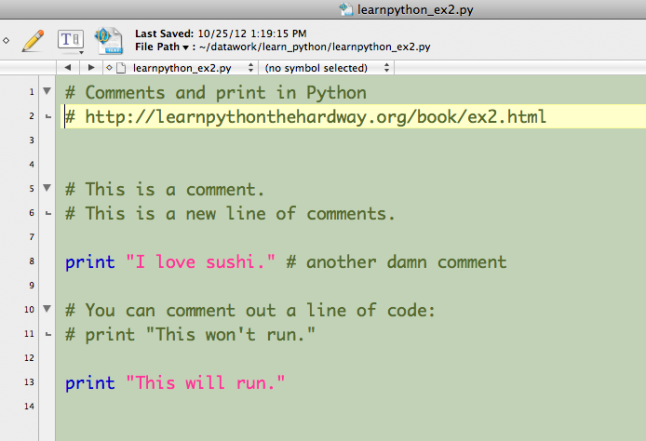You’ll be getting started on Zed Shaw’s Learn Python the Hard Way (LPTHW) this week.
You may certainly wait until after the first class meeting to begin. However, you would be smart to do the stuff on this page before the first class.

It is important that you do what Zed tells you to do. I chose this book for our class after I looked at dozens of books and online courses and videos about how to learn programming. Zed is awesome.
To get the benefits from Zed’s book, though, you really must do what he says. So:
- Start with the intro to the book, The Hard Way Is Easier, and read it top to bottom.
- Then read Exercise 0: The Setup, and do everything it says. Install and run Python on your own laptop. This is key. You need to have the programming environment ready at all times. You need to own it. Because if you’re going to learn this, you need to spend time with it.
- This might help you if you feel lost (three pages, with pictures): Week 1 Tips.
- After you’ve got Python running, work through Zed’s exercises, in order, top to bottom for each one. Type the code, just as he says. RUN THE CODE. Do all the study drills. Read everything — including the “common student questions.” It will all help.
You will be doing some of this in class. There will be hand-holding and advice. If you miss any of the first week of class, you are going to be behind. Very much behind. So don’t miss class. If you add this course at the end of drop/add, you’ll just have to try to catch up. No whining!
The first assignment
Your benchmark for Week 1 can be seen on the Course Schedule page. The benchmark indicates a reasonable or fair achievement for the week.
For the first week, you should do everything in the list above, and make sure to work through all of Zed’s exercises — up to and including 12. You should do this for an hour a day, every day, for seven days from Monday through Sunday, before our first class meeting in Week 2.
Your due date for completing the assigned work is your scheduled meeting time.
Your scheduled meeting time: During Week 1, you will schedule a time for Week 2 when you will sit down with me, your instructor, and show your work. This will be a time we agree on, student and professor, and we will meet at that time EVERY week. You will always bring your laptop to this meeting. Your grade depends on this meeting. Read about it in Required Work.
What if it’s too hard?
One goal in this course is for you to learn how to solve problems ( I do NOT mean math problems). If you get really stuck in an exercise in LPTHW, move on to the next exercise. Or search for help online. DO NOT let someone else do the work for you! Take a rest, take a break, and then — come back to it later.
I know you’re not a computer science major. This class is for you. It’s designed to help you learn how to learn.
In our scheduled meeting, you must show your work. Your code must include comments, written exactly as Zed explains to write them. Your code must be well organized. Your files must be well organized.
Above all, you must be able to explain what you did. If you got stuck, you must be able to explain what you did to try to get unstuck.
Your weekly grade depends on how you worked, what you produced, what you can show, and how you explain it.
Questions?
There is a Q&A discussion for Python questions already set up in our e-Learning space (log in to e-Learning here) — let’s keep code-specific questions in that space, please.
If you have a question about this week’s work, the benchmark, or what you should be doing to get your 1 or 2 points, please post that kind of question here, as a reply to this blog post.